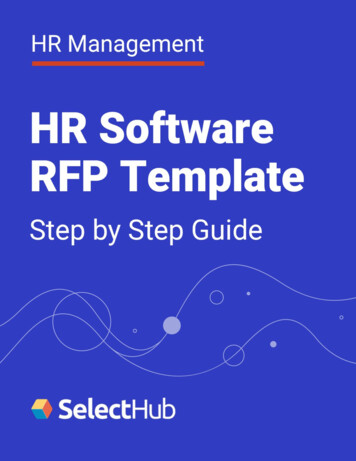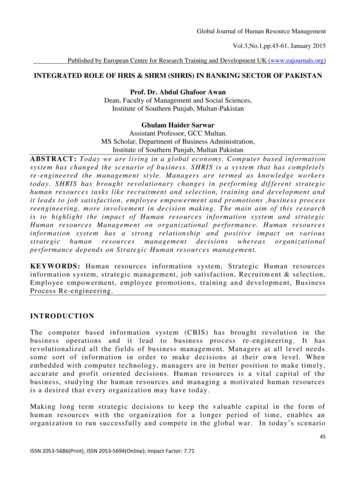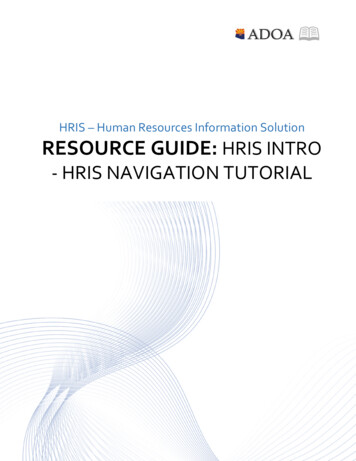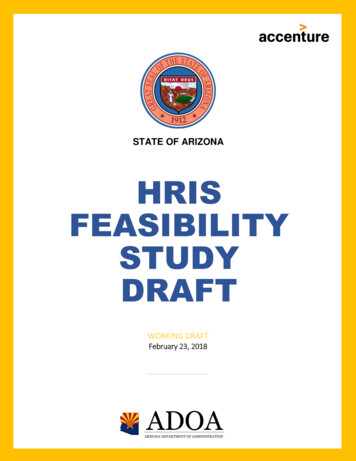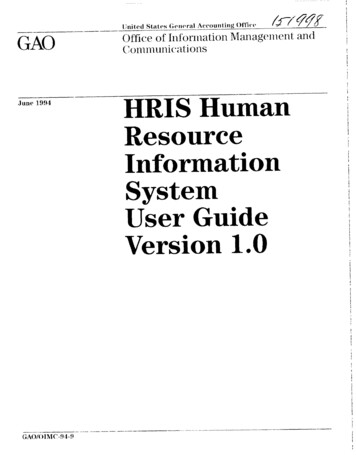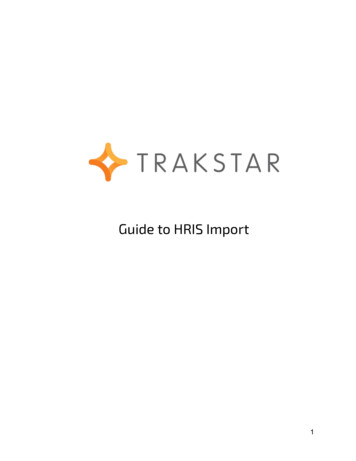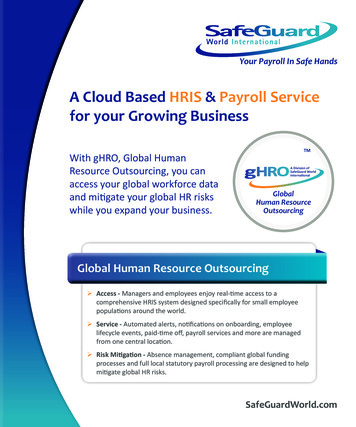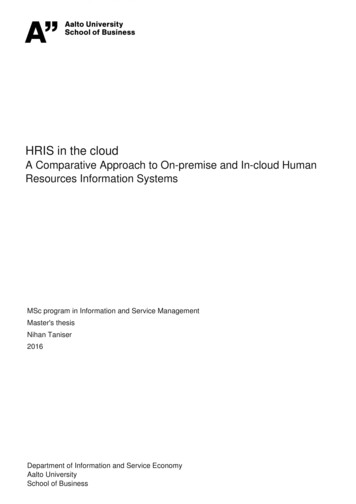
Transcription
HRIS in the cloudA Comparative Approach to On-premise and In-cloud HumanResources Information SystemsMSc program in Information and Service ManagementMaster's thesisNihan Taniser2016Department of Information and Service EconomyAalto UniversitySchool of BusinessPowered by TCPDF (www.tcpdf.org)
HRIS in the cloudA Comparative Approach to On-premise andIn-cloud Human Resources InformationSystemsMaster’s ThesisNihan Taniser9 June 2016Information and ServiceEconomyApproved in the Department of Information and Service Economy/ / 20 and awarded the grade
Aalto University, P.O. BOX 11000, 00076 AALTOwww.aalto.fiAbstract of master’s thesisAuthor Nihan TaniserTitle of thesis HRIS in the cloud: A Comparative Approach to On-premise and In-cloud HumanResources Information SystemsDegree Master of Science in Economics and Business AdministrationDegree programme Information and Service EconomyThesis advisor(s) Matti RossiYear of approval 2016Number of pages 77Language EnglishAbstractHuman resources information systems (HRIS) help a number of HR processes to be executed withthe help of IT. These systems are usually set up as on-premise systems, usually as a part of anEnterprise Resource Planning (ERP) system in large organizations. Latest developments in thecloud technology field has enabled Software-as-a-Service (SaaS)- or cloud-based HR systems, andtheir usage is proving to be a viable alternative to on-premise HR systems, although the adoptionlevels differ for different HR functions. Organizations are motivated to move their HR systems tocloud in order to benefit from new technology, reduce IT costs and standardize their HR processes.In-cloud HR systems differ from on-premise systems in many aspects including theirimplementation methodology, costs involved, the IT and HR skills needed to implement andmaintain these systems. Organizational readiness for the changes that come with cloud basedsystems and security issues regarding data in cloud based systems are some of the challengesorganizational face in their move to cloud.Keywords HRIS, cloud, SaaS, human resources systemsi
AcknowledgementsI would like to thank a number of people for their contribution and support in completion ofthis thesis, namely my supervisor Mr. Matti Rossi, all the experts I interviewed, and ofcourse, my family and friends.Also, here are my thanks to Ms. Amy Schumer for keeping me laughing during the writingprocess.ii
Table of ContentsAcknowledgements. ii1Introduction. 81.11.1.1Human Resource Information Systems (HRIS) .91.1.2Electronic Human Resource Management (e-HRM) . 141.1.3Enterprise Resource Planning (ERP) Systems and HRIS . 151.1.4Technological advances, Cloud technology and SaaS . 171.224Research questions . 19Literature Review . 212.1ERP in the cloud vs. ERP in-house . 212.2e-HRM research . 242.3SaaS adoption and cloud based HR information systems . 272.3.13Background.9Vendors and products for in-cloud HRIS . 29Methodology . 313.1Research design . 313.2Data collection . 313.2.1Online sources . 313.2.2Interviews . 32Findings . 344.1HR technology surveys . 344.1.1Adoption of SaaS/Cloud based HRIS. 344.1.2Motivations and expected benefits . 374.1.3Criteria for HR technology/product selection . 394.1.4Costs . 404.1.5Implementations and challenges . 404.1.6Concerns . 424.2Interviews . 424.2.1Motivations . 424.2.2Criteria for choosing cloud based HRIS . 464.2.3Company size . 484.2.4Implementation lifecycle . 504.2.5Comprehensiveness and hybrid landscapes . 554.2.6Organizational impact and HR/IT involvement . 59iii
54.2.7Common concerns and challenges . 604.2.8Future of cloud HRIS . 62Discussion. 645.15.1.1Theoretical implications . 645.1.2Managerial implications . 655.26Literature and findings . 64Limitations of the study and future research . 70Conclusions . 71Appendix A: Interview questions . 72References . 73iv
List of FiguresFigure 1. HR management activities (Source: Turban and Volonino, 2012) . 10Figure 2. Examples of information systems supporting HR at different levels (Source: Rainer,Prince, Watson, 2013) . 13Figure 3. How ERP interfaces with other enterprise systems (Turban and Volonino, 2012). 15Figure 4. e-HRM research framework (Source: Strohmeier, 2007) . 25Figure 5. Technology, organization and environment framework (Source: Tornatzky andFleischer, 1990; as used in Oliveira and Martins, 2011) . 27Figure 6. Oracle HCM Cloud Functionality (Source: Gartner 2015) . 30Figure 7. SAP SuccessFactors Cloud Functionality (Source: Gartner 2015) . 30Figure 8. Workday HCM Functionality (Source: Gartner 2015) . 30Figure 9. 2015-2016 HCM Technology Deployment (Source: Sierra-Cedar HR SystemsSurvey, 2015). On-premise deployments include combination and hosted environments. 34Figure 10. Prevalence of HR Technology Deployment Models (Source: ISG Industry Trendsin Human Resources Technology and Service Delivery Survey 2015). . 35Figure 11. HCM Deployments by size and HR function (Source: Sierra-Cedar HR SystemsSurvey, 2015) . 36Figure 12. General responses by on-premise customers when asked about their futuredeployment plans (Source: PwC HR Technology Survey 2014). 36Figure 13. Motivators to deploy HR applications in the cloud (Source: PwC HR TechnologySurvey, 2014) . 37Figure 14. Expected Benefits of HR SaaS Technology Solutions (Source: ISG IndustryTrends in Human Resources Technology and Service Delivery Survey 2015). 38Figure 15. Reasons for Moving to SaaS – HR, IT, and Executives (Source: Sierra-Cedar HRSystems Survey, 2014). 38Figure 16. Importance of Usability Features in Selecting New HR Technology (Source: ISGIndustry Trends in Human Resources Technology and Service Delivery Survey 2015) 39v
Figure 17. Implementation and support costs for on-premise and SaaS solutions (Source:Sierra-Cedar HR Systems Survey, 2015). 40Figure 18. HRMS Deployments timelines for on-premise and SaaS implementations (Source:Sierra-Cedar HR Systems Survey, 2015). 40Figure 19. Cloud implementation challenges (Source: PwC HR Technology Survey 2014) . 41Figure 20. Concerns with Moving to SaaS HRMS for HR, IT, Executives (Source: SierraCedar HR Systems Survey, 2014) . 42vi
List of TablesTable 1: Cloud types (Source: Rainer, Prince, Watson, 2013) . 17Table 2: Comparison of cloud service models with on-premise software (Source: Rainer,Prince, Watson, 2013) . 18vii
Introduction1 IntroductionThe cloud technology is transforming business. Human Resources (HR) as a field is notimmune to this change. The systems that have been enabling HR to perform its part arerapidly changing, and organizations, both in HR and IT departments, both at operative andexecutive levels, have to make decisions regarding how to run their business and whatsystems to use. A number of factors have influence in these decisions, and decision makersrepresenting organizations, just as it is with any other functional area information systems,will have a variety of choices for what tools and systems to use for which business processes,and how to acquire, integrate and manage these systems.In this changing environment for systems, cloud solutions are getting ever morepopular alongside on-premise (in-house) Enterprise Resource Planning (ERP) and HRinformation systems (HRIS). The HRIS landscape of an organization is most likely far frombeing homogenous and providing a standard solution for every HR functionality in theorganization, which makes the system related decisions even more complicated. Therefore,the system choice is not as simple as whether to keep everything on-premise or moveeverything to the cloud, as the vendors would like to suggest. Although this would makeintegration an obsolete job, the reality is almost always more complex and several systems,on premise and in-cloud, nowadays exist in elaborate landscapes. Especially in the case oflarger enterprises, every system related decision is a challenge that needs to be takenseriously.In this dynamic environment, a new way of managing HR and HRIS landscape requiresbetter understanding of real life cases and possibilities to evaluate future of HR informationsystems.The aim of this thesis study at the very basic level is to understand how recenttechnological changes revolving around cloud based HR systems impact, change andchallenge HR and IT both, motivated by the author’s own consulting background in the onpremise HR systems world.In this chapter first chapter, a background to the field of human resources informationsystems (HRIS) will be provided with an introduction to major HR functions and how IThelps HR to run. Later, the essential concepts relevant to this study such as e-HRM, ERP andHR systems as a part of ERP, and cloud technology related concepts including SaaS will beintroduced. At last the research questions will be listed.8
Introduction1.1 BackgroundIn order to discuss the issues related to solution architectures in the field of or relevant toHRIS in the further parts of this study, basic concepts related to the research topic will beintroduced in this chapter.Since the discussion presented in this study takes some HR systems that would beclassified as on-premise to be a part of an ERP system, this part will include a briefintroduction to ERP systems as well.1.1.1 Human Resource Information Systems (HRIS)Human resource information system (HRIS) refers briefly to integrated systems used tocollect, store, manipulate, retrieve, analyze and distribute information regarding anorganization’s human resources in order to support HR activities and managerial decisionmaking. (Hendrickson, 2013; Kavanagh, Thite, Johnson, 2015). A wider description of HRISwould include people using it, data it carries, policies and procedures it enables as well as asystematic way to maintain the software and hardware. A paper based system used for thesame purposes prior to a computerized system would also be considered an HRIS, but thisstudy will use the term to refer to the latter.History of HR related record keeping for the personnel departments in paper formsalready had started in the pre-World War II era, when “scientific management” was thedominant strategy to maximize productivity. Employment was defined by a contract betweenthe employee and the employer, with the near absence of any government regulation,therefore the record keeping was made mainly for the internal purposes, however there wasno IT-enabled HR activity yet in sight. In the post-World War II era until the 1960, albeit stillvery expensive, computers started to enter the business world, and payroll calculationsbecame the first HR function to be automated. During this era, job description basedcompensation programs and unionization was the defining movements in the field, and as aresult of increased influence of government agencies in industrial relations, employers startedto improve their record keeping practices. The influence of labor unions in the employmentrelations and the legal compliance requirements only increased during 1970s with thegrowing economy. This period also saw the declining IT costs, as well as the increase incomputerization of business functions and the appearance of first management information9
Introductionsystems (MIS), including for personnel departments, which by then had begun to be calledHR. The pressure to use more effective and efficient systems was mainly due to potentialpenalties a company could face in case of failing to comply with the rules and regulations.1980s and early 1990s was when HR function started to turn its focus from administrativetasks to personnel development, and managers were pushed to focus on return on personnelcosts in the face of intensifying competition. This trend and the fact that a computer-basedHR system was rather affordable for even smaller companies led to increased utilization ofIT, which resulted in a significant reduction in the time spent on transactional HR activities,and HR personnel was able to focus on more value-creating activities. From late 1990s untilpresent, with the backdrop of globalization, internet enabled services and outsourcing,technological advances transformed many HR processes into online processes and brought inunprecedented analytic capabilities, and possibilities for companies to transform HR into atruly strategic partner (Kavanagh, Thite, Johnson, 2015).In order to better understand the way that IT can facilitate the job of modern HRdepartment, a brief examination of HR management activities is useful. Figure 1 showsdifferent HR management activities, whose interdependent nature is indicated with thearrows that show the interactions.Figure 1. HR management activities (Source: Turban and Volonino, 2012)10
IntroductionThe key HR activities that are executed with the help of IT can be grouped as below(Turban and Volonino, 2012; Rainer, Prince, Watson, 2013):Recruitment: Recruitment process refers to finding candidates for employees,screening them using various methods and deciding which ones to hire. Whether there are toomany applicants interested in a position or too few, IT can help a company to handle theseapplications. Use of online recruiting tools can result in reaching out to a wider network andcan bring in candidates with the right qualifications, which works similarly for the applicantswhere they can easily find out about jobs suitable to their qualifications and interests. Thesetools can enable searching and shortlisting candidates and tracking their applicationprocesses, making it more transparent to those involved in the recruitment process within theorganization and to the applicants.Usage of social networks for recruitment has become very popular and increasinglyintegrated into recruitment process. Social networks such as LinkedIn offer possibilities toemployers to search for candidates and post jobs and receive applications. External socialnetworks can be integrated with applicant tracking system (ATS); for example, a candidatecan authorize such a system to collect data from their LinkedIn profile (Bradley, 2015).Human Resources Development: After hiring, an employee’s performance istypically kept track of via periodical performance assessments, and based on theseassessments, companies develop their workforce by offering trainings to their employees.Performance evaluation and training are two areas of HR management where IT is heavilyinvolved.Digitized performance management systems make it significantly easier for employeesand managers to participate in a cycle of performance evaluation. The individual targets fordifferent performance areas based on organizational targets can be agreed upon by employeesand their managers, and at the end of evaluation period, employee’s performance is assessedby themselves, their managers, and sometimes their teammates. This process and thefollowing salary review can be started by automatized systems that would, for example, sendemails to employees and managers at the set times and directing them to the forms theywould need to fill and continue the process according to set workflows. Collecting this datamanually and running such a complex process on paper can easily lead to errors and wouldtake a much longer time. The data collected during the performance evaluation process can11
Introductionbe used for systematic analysis of performance, decisions regarding promotions, transfers, orlayoffs, rewards, salary reviews, and training needs.Trainings are an important part of human resource development activities. In order tostay competitive, companies understand the strategic importance of developing the talentbase they have and keeping the skills of the employees relevant in an evolving market.Organizations that invest in their human capital build a career plan for their employees,which means keeping the employees trained.Organizing training activities has seen some of the most extensive digitaltransformations in the field of HR. In addition to planning and monitoring trainings on alarger scale on IT applications, interactive web-based learning, also called e-learning, hasbeen changing the way training content is provided. The web based multimedia trainings canbe used to either support conventional classroom trainings or completely replace them withvirtual classrooms. E-learning can deliver high quality and current content in a consistentway across training sessions, usually letting employees take the course at a time and placethat suits them, and at their own pace. It also allows large number of learners access thecontent at the same time, practically ruling out any capacity issues (Rainer, Prince, Watson,2013).Human Resources Planning, Control and Management: IT can support three majorareas in managing an organization’s workforce: employee records and payroll, benefitsadministration, and employee relationship management.First one refers to keeping basic employee data (employee master data) that is relevantfor other HR processes, and preparing payroll, which will be calculated in an automated wayand result in paychecks being prepared and sent to the employee and money being transferredto employee’s account.Second is benefits administration, which includes wages, bonuses and other benefits.Benefits can include healthcare, dental care, pension contributions, child care centers,disability or unemployment benefits. This can be a complex area for a company that letsemployees to negotiate benefits on a personal basis. Some of these are possible to registerand manage by employees themselves by using online self service tools via company portals.Organizations also develop employee relationship management (ERM) applications inorder to better manage the workforce all through the employment life cycle from hiring toleaving the company. This includes a wide variety of activities, such as providing access to12
Introductionself-service tools for employees to update their basic information, enter leave data and seewhen their leave requests are approved, shift management, enrolling to trainings,communicating their grievances with managers and HR, participating in regular employeesatisfaction surveys.Based on the grouping of HR activities and examples of HRIS above, an overview ofhow information systems can support HR function at different operational levels can beshown as Figure 2 with examples.Figure 2. Examples of information systems supporting HR at different levels (Source: Rainer, Prince, Watson,2013)Wright, McMahan, Snell and Gerhart similarly group the HR activities in three broadcategories as “transactional, traditional, and transformational”. Transactional activities aretypically day-to-day activities relevant to regular bookkeeping, such as updating anemployee’s contact information, updating payroll related information or keeping track oflunch benefits or bonuses. Traditional activities are recruitment, hiring, training, planning,compensation and performance management, and they can add significant value to theorganization if their outcome is in line with the strategic targets of the company.Transformational activities, on the other hand, refer to those actions whose impact would bean organization-wide added value, such as “cultural or organizational change, structuralrealignment, strategic redirection, and increasing innovation.” (as cited in Kavanagh, Thite,Johnson, 2015).13
IntroductionUsing the classification above and referring to the historical evolution of HRIS,Kavanagh et al. (2015) also make note of the change in the role of HR management frombeing primarily dealing with routine “transaction and traditional HR activities” toincreasingly “transformational HR activities” in the past decades. This is an important pointin understanding and evaluating the current changes in the landscape and composition ofHRIS, since allowing HR to focus on more strategic side of business by making theadministrative processes more efficient by outsourcing or deploying certain systems is still avalid driver for businesses.HRIS is a field with many stakeholders in an organization: First and foremost, HRprofessionals rely on the system to do their jobs. These may include record keeping, payroll,legal reporting to authorities, skills management of the employees. Second is the managers,who require information from the HR systems regarding their team, performance relatedgoals and appraisal data and time planning data such as shift plans and leaves. At last,employees use the systems where they manage their benefit options, update their own data,participate in trainings and automated performance appraisal processes. Therefore, HRIS caneasily be described as the “backbone” of modern HR (Hendrickson, 2003).1.1.2 Electronic Human Resource Management (e-HRM)Parry and Tyson (2011) define e-HRM quite comprehensively as “a way of implementing HRstrategies, policies and practices in organizations through a conscious and directed supportand/or with the full use of web-technology-based channels”. This refers to a broad set ofactivities that can be executed with the help of web technologies from the employee’s joiningin an organization all they way through his employment until his retirement or termination;the list includes but is not limited to recruitment, performance management, career andsuccession planning, training/learning, benefits administration and employee datamaintenance, time data collection, employee surveys, and termination processes.In his review of the existing e-HRM literature, Strohmeier (2007) refers to technology’srole as both connecting geographically separated participants of a process, and supportingand even substituting them in their tasks in these processes. In comparison to other termsused for the concept such as “virtual HRM”, “business to employee (B2E)” and “Web-basedHRM”, e-HRM can cover wider properties of these systems like having non-computer14
Introductioncomponents, involving other actors than business owners and employees, and beinginterfaced to ERP-systems (Strohmeier, 2007).Although e-HRM by itself does not have any specific indication as to how the systemin question is procured, implemented, hosted or maintained, it represents a shift in HRIS anda certain, significant change in the ways of working of HR that is defined and enabled by thetechnological advances. Additionally, e-HRM research can provide guidelines to how toapproach and position a research with a technology focus such as this one in relation to theHR research domain.1.1.3 Enterprise Resource Planning (ERP) Systems and HRISIn order to be able to evaluate the recent changes in the field of HRIS, the author considersthat HRIS’ existence as a part of an Enterprise Resource Planning (ERP) system need to beincluded in the study.ERPs are extensive, packaged enterprise software that have started gaining wide spreaduse in business already in 1970s, and they can be considered one of the oldest kind ofmanagement information systems. In the past decades they gradually became an omnipresentsolution for organizations, especially large companies that want to benefit from integratingtheir business processes by using a unified database and a single IT architecture (Klaus,Rosemann, Gable, 2000).ERP systems serve different business functions in an integrated manner, and thereforehas different “modules” that correspond to different business functions such asManufacturing, Sales and Distribution, Finance and Controlling, Human Resources, SupplyChain, Customer Relationship Management (Figure 3).15
IntroductionFigure 3. How ERP interfaces with other enterprise systems (Turban and Volonino, 2012)Some of the most defining characteristics of ERP systems are that they are (1) modular,that they are comprised of different modules corresponding to different departments of abusiness organization, (2) customized, that they typically go through a configuration processbefore being taken into use in order to fit to and serve the specific business processes of anorganization, (3) industry-specific, that they can be acquired as preconfigured for differentindustries such as banking, retail, telecommunications, etc. and (4) interfaced, that they arelinked to other systems within or outside the organization
maintain these systems. Organizational readiness for the changes that come with cloud based systems and security issues regarding data in cloud based systems are some of the challenges organizational face in their move to cloud. Keywords . HRIS, cloud, SaaS, human resources systems


